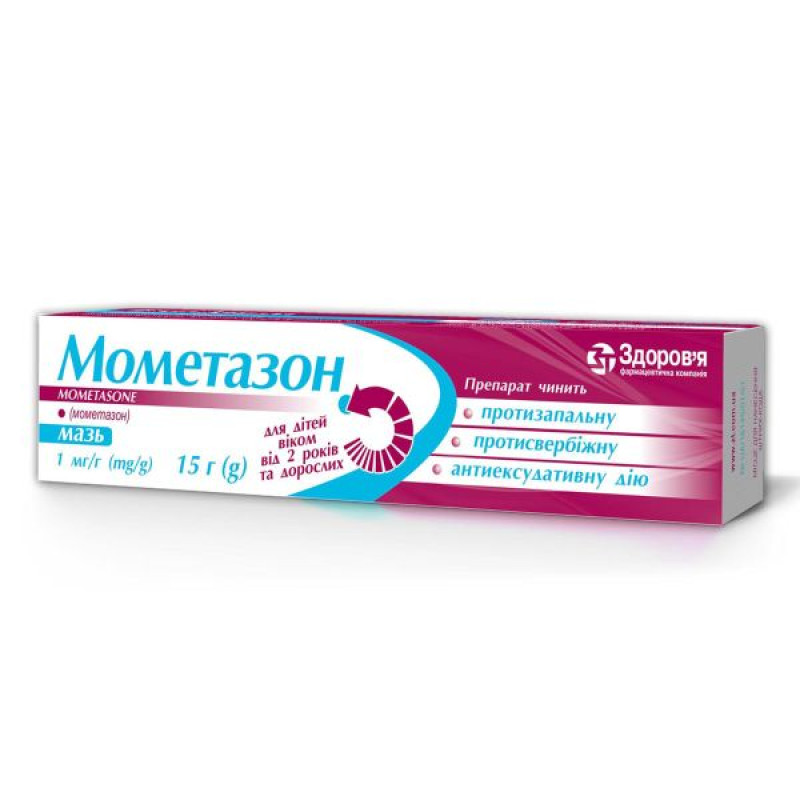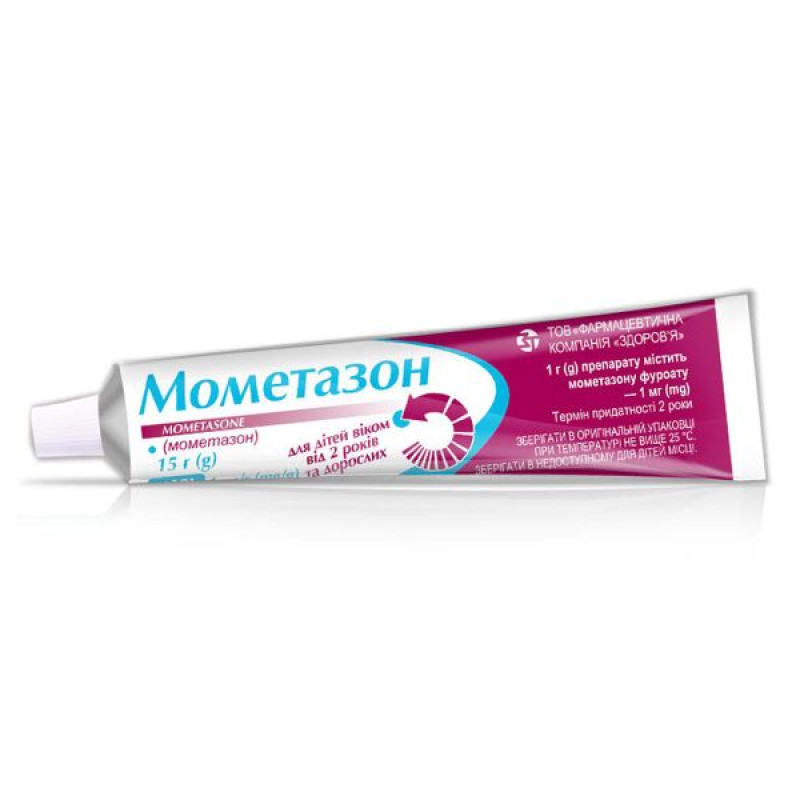Mometasone ointment 1 mg/g tube 15 g

Instructions Mometasone ointment 1 mg/g tube 15 g
Composition
active ingredient: mometasone;
100 g of ointment contains mometasone furoate in terms of 100% substance – 0.1 g;
excipients: hexylene glycol, propylene glycol monopalmitostearate, white wax, purified water, diluted phosphoric acid, white soft paraffin.
Dosage form
Ointment.
Main physicochemical properties: white or almost white ointment.
Pharmacotherapeutic group
Corticosteroids for use in dermatology.
ATX code D07A C13.
Pharmacological properties
Pharmacodynamics.
Mometasone furoate is a synthetic glucocorticosteroid for topical use with anti-inflammatory, antipruritic, and antiexudative effects.
Pharmacokinetics.
Pharmacokinetic studies have shown that systemic absorption after topical application of mometasone furoate 0.1% is minimal; approximately 0.4% of the applied dose is excreted from the body within 72 hours after application. It was practically impossible to determine the nature of the metabolites due to the small amounts present in blood plasma and excretion.
Indication
Inflammatory phenomena and pruritus in dermatoses responsive to corticosteroid therapy, including psoriasis (except generalized plaque psoriasis) and atopic dermatitis, in adults and children aged 2 years and older.
Contraindication
Moleskin® is contraindicated in rosacea, acne vulgaris, skin atrophy, perioral dermatitis, perianal and genital pruritus, diaper rash, bacterial (e.g. impetigo, pyoderma), viral (e.g. herpes simplex, herpes zoster and varicella, warts, genital warts, molluscum contagiosum), parasitic and fungal (e.g. candida or dermatophyte) infections, tuberculosis, syphilis or post-vaccination reactions. Moleskin® should not be used on wounds or ulcerated skin. The drug is contraindicated in patients with hypersensitivity to any of the components of the drug or to other glucocorticosteroids.
Interaction with other medicinal products and other types of interactions
Not installed.
Application features
If irritation or sensitization occurs, discontinue use of the drug and institute appropriate treatment.
In case of concomitant skin infection, an appropriate antifungal or antibacterial agent should be used. If positive dynamics are not achieved within a short time, the use of Moleskin® ointment should be discontinued until the infection is completely eliminated.
Due to systemic absorption, topical administration of various corticosteroids may cause reversible suppression of the hypothalamic-pituitary-adrenal axis with possible glucocorticosteroid insufficiency after discontinuation of treatment. Cushing's syndrome, hyperglycemia, and glycosuria may also develop.
Patients receiving topical corticosteroids for the treatment of large areas of skin or with occlusive dressings should be periodically monitored for signs of hypothalamic-pituitary-adrenal axis suppression. This can be done by performing an ACTH stimulation test, measuring morning plasma cortisol levels, and measuring serum cortisol levels in other media than urine.
Any side effects seen with systemic corticosteroids, including adrenal suppression, may also occur with topical glucocorticosteroids, especially in infants and children.
Occlusion should not be used for children. Also, do not apply occlusion to the face. Avoid contact of the ointment with mucous membranes.
Abrupt discontinuation of long-term treatment may result in a rebound effect in the form of dermatitis with intense redness, irritation and burning. This can be prevented by gradual withdrawal of the drug, e.g. intermittent treatment, until complete discontinuation.
Glucocorticoids may alter the appearance of some lesions and make it difficult to make an appropriate diagnosis, which will also delay recovery.
The product contains propylene glycol, which may cause skin irritation.
Moleskin®, ointment for external use, 0.1% is not intended for use in ophthalmology, including application to the eyelids. The product should not be allowed to come into contact with the eyes.
Use during pregnancy or breastfeeding
It is not known whether topical corticosteroids can cause significant systemic absorption to be detected in breast milk. Moleskin® should be used during breast-feeding only after a careful benefit-risk assessment. If treatment is prescribed in high doses or for a long period, breast-feeding should be discontinued.
The ability to influence the reaction speed when driving or working with other mechanisms
Not installed.
Method of administration and doses
Apply a thin layer of Moleskin® ointment to the affected areas of the skin once a day. The duration of treatment is determined by the severity and course of the disease and is determined individually.
The use of topical corticosteroids in children, as well as on the face, should be limited to a minimum amount, giving preference to effective therapeutic regimens, and the duration of treatment should not exceed 5 days.
Children.
Children over 2 years of age should use the drug only as prescribed by a doctor.
Because children have a greater surface area to body weight ratio than adults, they are more susceptible to hypothalamic-pituitary-adrenal (HPA) suppression and Cushing's syndrome with any topical corticosteroid, especially when applied to more than 20% of the body surface area.
It is recommended to use the smallest amount of glucocorticosteroids necessary to obtain a therapeutic effect, especially in children. The course of treatment should not exceed 5 days. Long-term corticosteroid therapy may delay the growth and development of the child.
The safety of mometasone in children for more than 6 weeks has not been studied.
There are only limited data regarding the treatment of children under 2 years of age.
Moleskin® should not be used to treat diaper dermatitis.
The ointment should not be used under occlusive dressings unless directed by a physician, and should not be applied to areas under diapers or underwear that do not allow moisture to pass through.
Overdose
Excessive prolonged use of topical corticosteroids may suppress the function of the hypothalamic-pituitary-adrenal axis, which may manifest as secondary adrenal insufficiency, which is usually reversible.
In case of suppression of this system, the interval between applications should be increased, or glucocorticosteroids with less activity should be used, or the drug should be discontinued.
The steroid content in each tube is so small that in the event of accidental ingestion of the drug, the toxic effect will be almost imperceptible or absent.
Side effects
Infections and infestations: folliculitis, infections, boils.
From the nervous system: burning sensation, paresthesia.
Skin and subcutaneous tissue disorders: pruritus, contact dermatitis, skin hypopigmentation, hypertrichosis, atrophic skin streaks, acneiform dermatitis, skin atrophy.
General disorders and administration site conditions: application site pain, application site reactions.
Propylene glycol, which is part of the drug, can cause skin irritation.
Local adverse reactions that have been reported infrequently in association with the use of topical dermatological corticosteroids include: skin dryness and irritation, dermatitis, perioral dermatitis, skin maceration, increased lesion area, increased allergic manifestations, erythema, striae, telangiectasias, papular, pustular eruptions, and tingling sensation.
Expiration date
3 years.
Do not use the drug after the expiration date indicated on the package.
Storage conditions
Store at a temperature not exceeding 25 ° C. Keep out of the reach of children.
Packaging
15 g in a tube. 1 tube in a pack.
Vacation category
According to the recipe.
Producer
JSC "Farmak".
Location of the manufacturer and its business address.
Ukraine, 04080, Kyiv, Kyrylivska St., 74.
There are no reviews for this product.
There are no reviews for this product, be the first to leave your review.
No questions about this product, be the first and ask your question.






